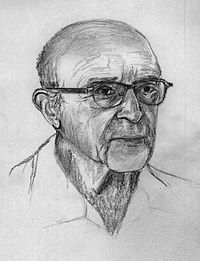
Photo from wikipedia
Abstract Firstly, this paper aims to analyze how verbal and visual modes contribute to build two basic components of cartoons: the referenced situation and the fictional situation. Secondly, it aims… Click to show full abstract
Abstract Firstly, this paper aims to analyze how verbal and visual modes contribute to build two basic components of cartoons: the referenced situation and the fictional situation. Secondly, it aims to unravel the semiotics of this discursive genre by offering a fine-grained picture of modal variations and continuities of the rhetorical resources deployed, by means of which the fictional situation is displayed. The corpus is composed of 50 multimodal cartoons chosen by cartoonists of 22 nationalities as the most representative of their work in the frame of a wide questionnaire. Category analysis and non-parametric statistics were applied. We identified and fleshed out four different types of modal functioning of resources: visual preference, verbal preference, modal flexibility, and genuine multimodal functioning. Even if visual and multimodal metaphor were often in charge of transferring meaning from fiction to the referenced situation, results show that other resources such as antithesis, irony, and syllepsis can become the key resources of cartoons. Findings highlight the multilayered functioning of cartoons, among which plastic features can play a significant role, and provide further evidence in favor of the hyperdetermination of humor hypothesis proposed by Attardo.
Journal Title: Semiotica
Year Published: 2019
Link to full text (if available)
Share on Social Media: Sign Up to like & get
recommendations!